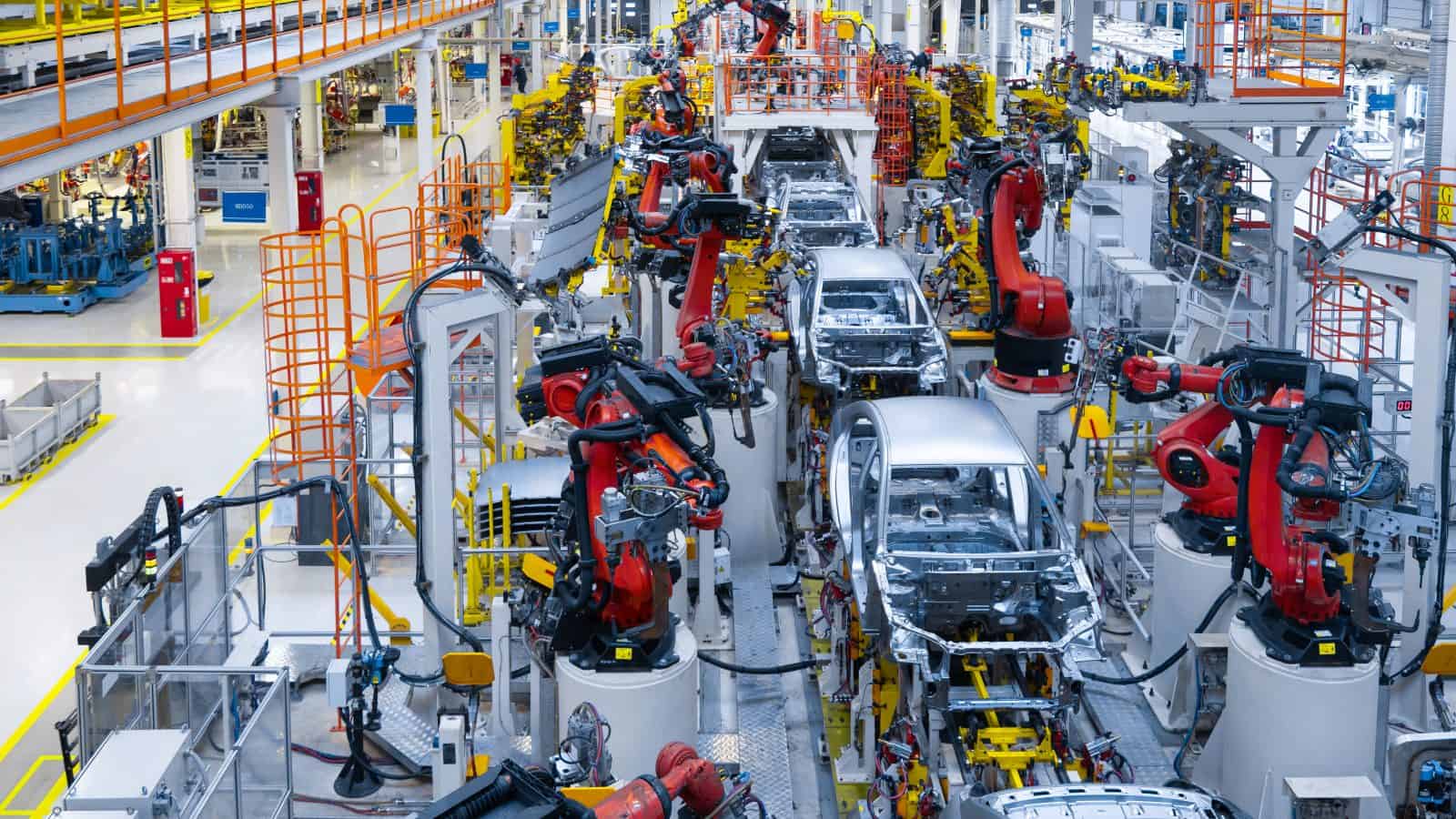MLC Announces New 2022/2023 MLC Critical Issues Agenda
The Journey to M4.0 Value
The manufacturing industry is at a pivotal point in its history.
Driven by market forces to become more agile, innovative, resilient, cost efficient, and sustainable, companies of all sizes are pursuing a future vision for business value enabled by digital technologies that will redefine the rules of competition, how work will be performed, how companies will be organized, and how leadership must lead.
We term this future state: Manufacturing 4.0.
Such a comprehensive enterprise-wide transformation requires a three-dimensional approach: mastering the challenges and opportunities of advanced digital tools and data; improving organizational structures and cultures; and developing new workforce talent and leadership skills.
While shaped by company size, sector, and level of digital maturity, all manufacturers share the need for a common set of key M4.0 competencies.
These enable them to drive value from digital investments in critical areas of business activity – from product design and innovation, to supply chains and customer relationships, to more eco-efficient manufacturing operations.
The Manufacturing Leadership Council’s new Critical Issues agenda for 2022/2023 is a specifically designed to help manufacturers align their thinking and best practices to deliver true business value from their journey to M4.0.
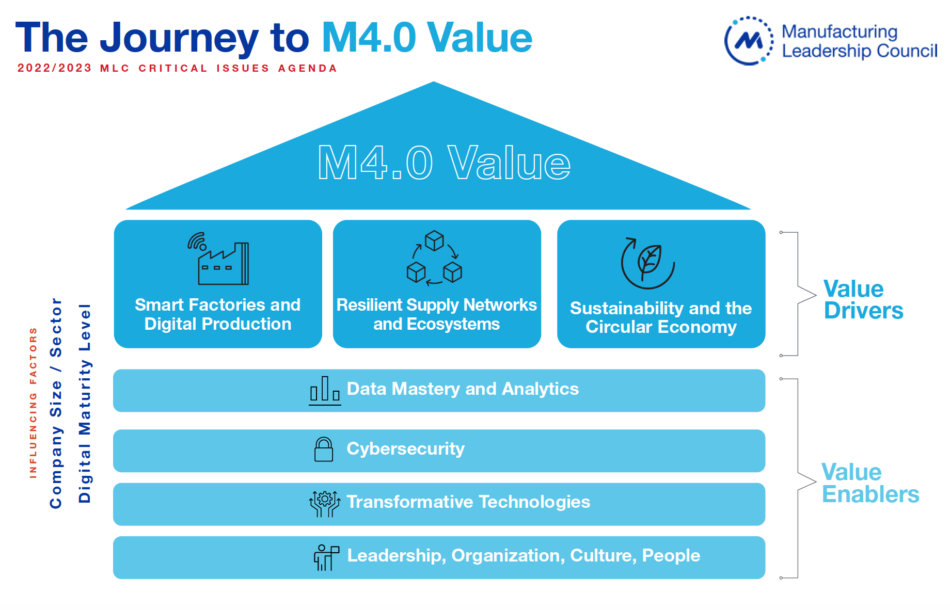
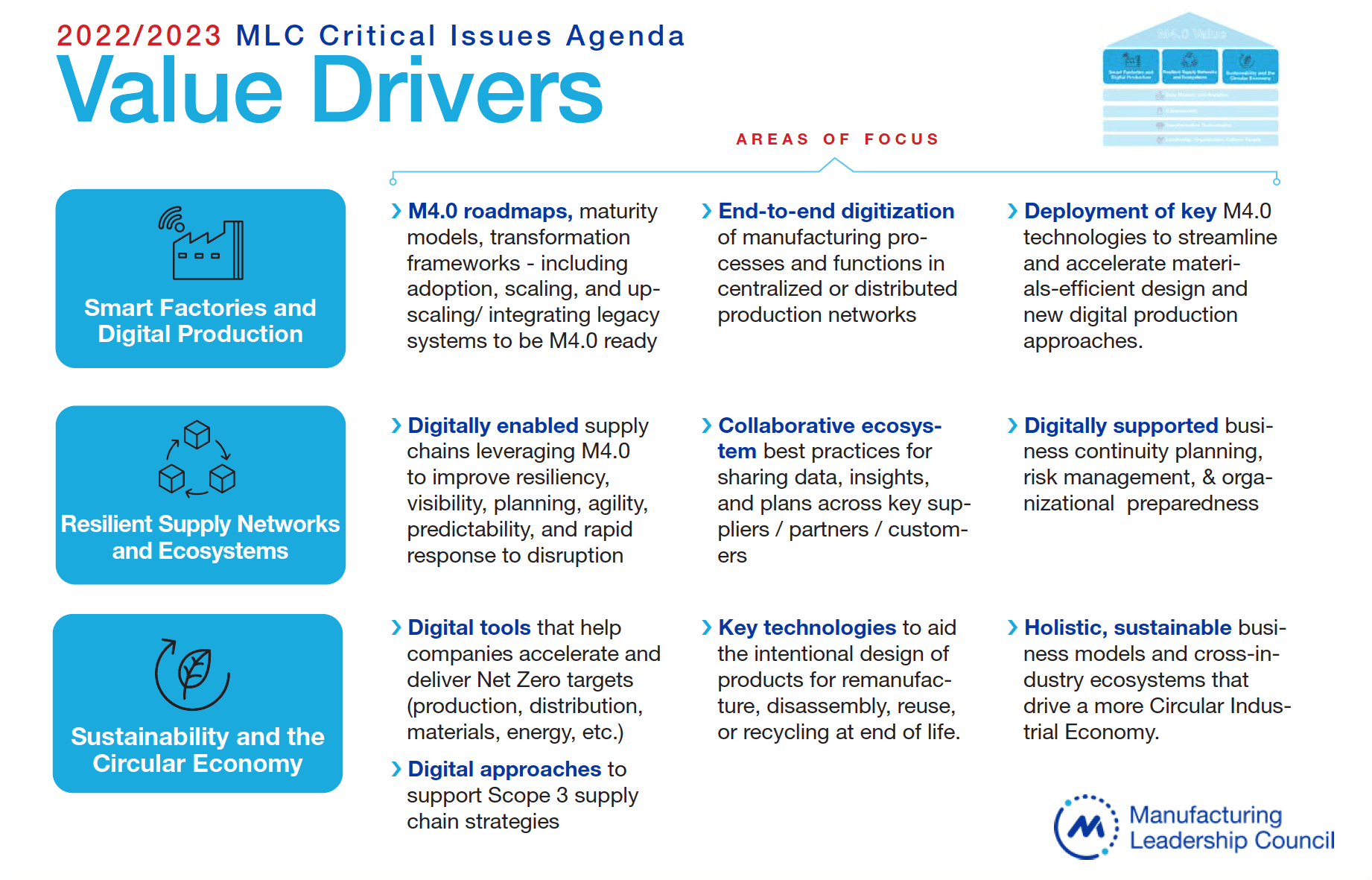
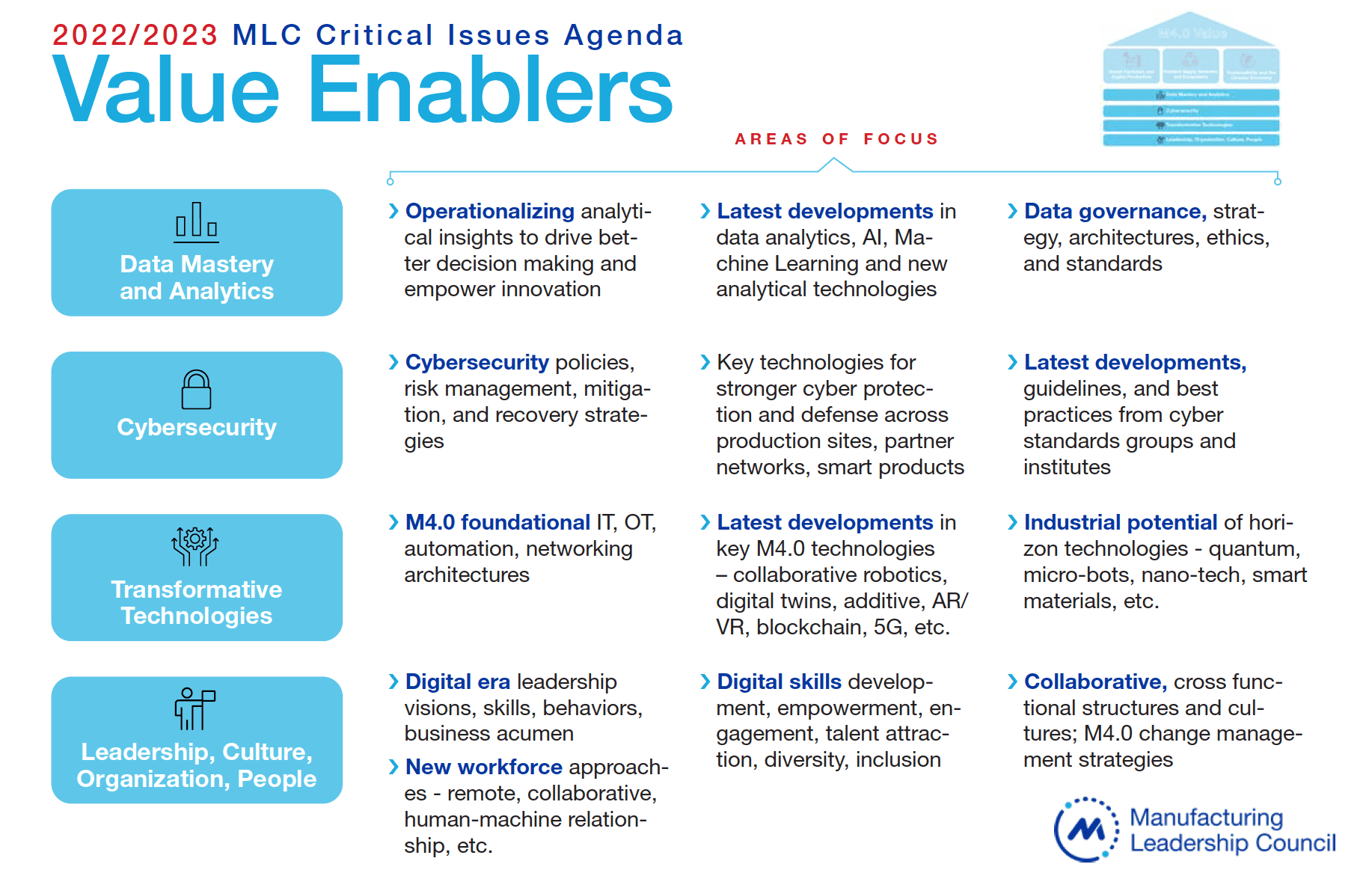
The MLC’s Critical Issues Process
The Manufacturing Leadership Council’s Critical Issues agenda, now in its 11th year, is the outcome of a unique, annual, member-driven process to identify the most urgent and important issues facing manufacturing companies in the year ahead. Refreshed every year, it is based on extensive consultation with over 3500 senior executives and associate members of the Manufacturing Leadership Council and Board of Governors.
The Critical Issues agenda establishes the Manufacturing Leadership Council’s strategic plan, and directly influences all major elements of the MLC’s research program, content focus, events, and services portfolio for the year ahead.
For more information contact: [email protected]
Technology and Communication for the New Workforce Generation

Two statements, from two people deeply immersed in the manufacturing sector, have been playing on loop in my head recently. The first was something said to me by Joe Chen, co-founder of one of our customers, Anduril Industries. He said that his company’s fundamental differentiator (and thus his most important KPI) is being faster to market than everybody else.
The second was an observation I read made by Paul Wellener, Vice Chairman and U.S. Industrial Products & Construction Leader at Deloitte LLP. Wellener, who also serves on the NAM Board of Directors, said, “The challenge is to really make manufacturing attractive to the next generation and to diverse populations.”
It’s hard to argue with either statement. Advances in manufacturing technology are driving dramatic acceleration in development, iteration, and production. And with supply chain problems causing drag on the entire sector, the ability to beat the competition for pace makes you far more likely to win.
Meanwhile it’s been well documented that the older part of the U.S. population is leaving work in droves. More than half of over-55s have quit the U.S. workforce, taking with them decades of knowledge and expertise and leaving a gap which must be filled by younger generations.
But those millennials, who will account for 75% of the workforce by 2025 according to some projections, have a level of choice in employment terms that we haven’t seen for decades. It’s a seller’s market and, with the U.S. manufacturing sector on track to have over two million unfilled jobs by 2030, the urgency behind Paul Wellener’s observation becomes clear.
So it is reasonable to conclude that success in manufacturing as we move forward will be heavily dependent on speed and agility, combined with the ability to attract and retain the best new talent from a pool of workers who are younger, and increasing in diversity of nationality in line with the population as a whole.
Studies suggest that technology has a crucial role to play. According to research from Comptia, 71% of millennials cite the degree to which an organization embraces technology and innovation as an influencing factor in their choice of an employer – a share of the cohort which is increasing each year. They want access to the best technology that will have the greatest impact on their skillsets.
In addition, the survey showed that 61% of millennials like to use their smartphone as part of their working life, compared to just 38% of boomers. Anecdotally, I see the same thing. They want to work as they live, with the same technology – and that means that the ways in which information is accessed, presented, and consumed must change.
Our own research into how product and process documentation is managed within the U.S. manufacturing sector revealed more generational differences in this area. We asked manufacturing professionals from middle management through to executive leadership whether they agreed that text-heavy documentation was challenging because of diverse reading skill levels and first languages. While 66% of those in the 45–54-year-old age group agreed, the number rose to 74% for those aged 35 to 44 and to 81% for those aged 25 to 34.
Where it gets interesting for me is the intersection between that need to beat competitors on time to market and the need to change how information is consumed (and to provide technology that engages and excites the workforce). The reality, of course, is that you are only as fast as your slowest process. And because effective communication of critical product and process information underpins every aspect of success, it has to be on the money.
Our survey suggests this is understood, with 75% of manufacturers reporting that they are actively trying to improve their communication processes, and 73% saying that communication is getting harder for them to manage as they grow. Most telling of all, 73% said they believe poor communication processes are undermining the investments they’ve made in other technology and process initiatives.
These issues are driving uptake of our interactive visual communication and collaboration platform, Canvas Envision because it provides that very step change in how information is delivered and consumed that chimes with the learning styles of the new generation workforce.
The challenges are not going away, but fortunately there is a solution.
 About the author:
About the author:
Patricia Hume is Chief Executive Officer of Canvas GFX.
Rethink 2022: Avoiding a Digital Divide
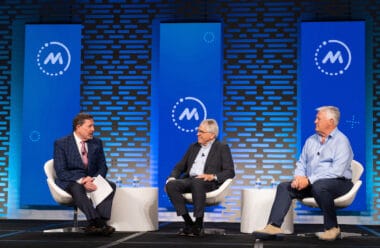
When it comes to digital transformation, is there a way to ensure that all manufacturers have an equal opportunity to focus on digital initiatives – regardless of their size? A panel at Rethink: The Manufacturing Leadership Council Summit examined the different challenges faced by small and medium enterprises on the industry’s journey to Manufacturing 4.0.
The panel featured Val Zanchuk, President at Graphicast; Chuck Wetherington, President of BTE Technologies and SMM Chairman for the NAM Board of Directors; and Irene Petrick, Senior Director of Industrial Innovation at Intel Corporation.
The most obvious challenge comes from resources. As Zanchuk said, he is often limited by the three T’s: Time, Treasury, and Talent. “I try to keep up with the pace of understand what’s going on with the latest digital tools, and identify the opportunities that make sense for the business.”
“M4.0 is not a rote prescription, it’s a toolbox,” Wetherington said. “We are moving digital technology down to where the work is being done.”
Petrick said that the digital divide isn’t only because of size, but also because of investment choices. “If you weren’t doing a lot of investments in digital over time, then you are behind – it’s not a size issue, it’s an investment issue.” Petrick added that companies who have not been making those continuous investments are behind, especially after COVID.
Cybersecurity is also a concern, not just internal to a company but also as an ask from customers. “The customer base has to be able to look at us and say we’re in good shape, to be comfortable working with us,” Zanchuk said.
Wetherington added, “Every company needs to be worried about cyber and needs to make efforts to be secure. The problem isn’t how good your defense is, it’s whether or not the bad guys want to get at you.”
So how can a small company, or any company, keep from falling into the divide?
“You have to stay on top of understanding technologies,” Zanchuk said. “Lean mentality fits well with 4.0 mentality, but we don’t use every tool in the Lean toolbox. I’m always scanning the technologies to understand it and translate it down to my scale.”
It’s also a matter of people, not just technology. “Hiring and retaining talent will continue to be an enormous challenge,” Petrick said. “Investing there will yield much more value than ever before.”
Rethink 2022: Tomorrow’s Manufacturing Leaders Speak Up
Panelists discuss access, cross-functional teams, lessons learned and more at Rethink

Katelyn Kelsey didn’t expect to go into manufacturing, but as an engineer, the lure of digital transformation and the opportunity to solve emerging problems was too great.
Participating in a panel discussion on next-generation leaders at MLC’s Rethink 2022 Summit, the Mobility Technology Engineer for Dow, Inc., encouraged employers to go back to the drawing board and to let young people know that manufacturing is a place where they can work with the latest technologies and solve problems that bridge information technology and operational technology.
Moderated by Penelope Brown, MLC’s Senior Content Director, the panel also included Hayley Dwight, Director, Business Architecture and Change Management for Cooley Group, and Daniel Shrives, Research Engineer for Saint-Gobain North America.
The panelists agreed that Gen Z and millennials want to work for companies with interdisciplinary teams that do not operate in silos. Further, Dwight explained that her generation also wants a culture that values information sharing between organizational levels. She shared that she’s able to direct message with people like Jack Dorsey – the co-founder and former CEO of Twitter – so she should have similar access to the leaders in her our organization.
Later Kelsey added, “It costs you nothing to offer a seat at the table.”
Meanwhile, Shrives shared that one of the most important lessons he’s learned so far is to be flexible and expect that a role and responsibilities will change over time. But it is not just about his generation’s expectation to adapt. Shrives shared that leaders should give millennials an opportunity to bring change with them.
To prepare for the future, Kelsey encouraged manufacturers to come to events like Rethink in order to have candid conversations as an industry. She also reminded the audience that manufacturers aren’t just manufacturers anymore. They are also technology companies and they need to pull talent from other industries to create cross-functional teams.
And it is not just about speaking truth to power. Each of the panelists is also working to build their own leadership skills. In fact, Dwight, Kelsey and Shrives were among those honored later in the Next-Generation Leadership category at the Manufacturing Leadership Awards Gala.
Asked to share something about her personal development journey, Dwight shared that she’s working to ask more questions instead of making declarative statements. To do this, she asks herself each day if she ended more sentences with question marks or periods. That’s a lesson for leaders regardless of their generation.
Photo by David Bohrer / National Assoc. of Manufacturers
Rethink 2022: Data Literacy Connects Employees to a Common Digital Thread
Embracing data literacy helps Entegris advance Manufacturing 4.0 journey
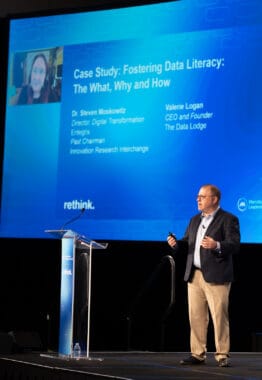
In 1914, the Ford English School fostered shared language between the company’s workers who spoke many languages and had diverse perspectives. By establishing a shared understanding and fluency in the English language, Ford’s school led to increased safety and efficiency and better citizens.
Now more than one hundred years later, data literacy is the baseline language according to Valerie Logan, CEO and Founder of The Data Lodge.
Logan and Dr. Steven Moskowitz, Director, Digital Transformation at Entegris and Chairman of Innovation Research Interchange (IRI), a division of the National Association of Manufacturers, presented a case study at MLC’s Rethink 2022 Summit titled Fostering Data Literacy: The What, Why and How.
The case study explained that data literacy is the language of data – the ability to read, write, and communicate with data in context. Logan emphasized that the context is important and differs depending on a person’s role. Further, she said, mindset, language and skills are the keys to fostering data literacy.
When Entegris kicked off its digital journey, they took time to examine the corporate culture and then aligned their digital strategy with that culture so different teams could connect to Entegris’ digital thread and move from data to insights to actions and decisions. Logan shared that fostering community and collective languages across a diversity of backgrounds opens new channels for the entire organization.
For Moskowitz, data literacy isn’t about dumping data on people. It is important to communicate the story and explain the decisions and actions that the data necessitates.
At its core, data literacy is a development tool, but it requires enablement and engagement. According to Moskowitz, the impact of shared data literacy isn’t always measurable, but if you don’t establish literacy, the cost could be significant.
Photo by David Bohrer / National Assoc. of Manufacturers
Rethink 2022: Supply Chain Through a New Lens
Greater visibility and an engaged workforce are key to overcoming long-lasting supply chain disruption
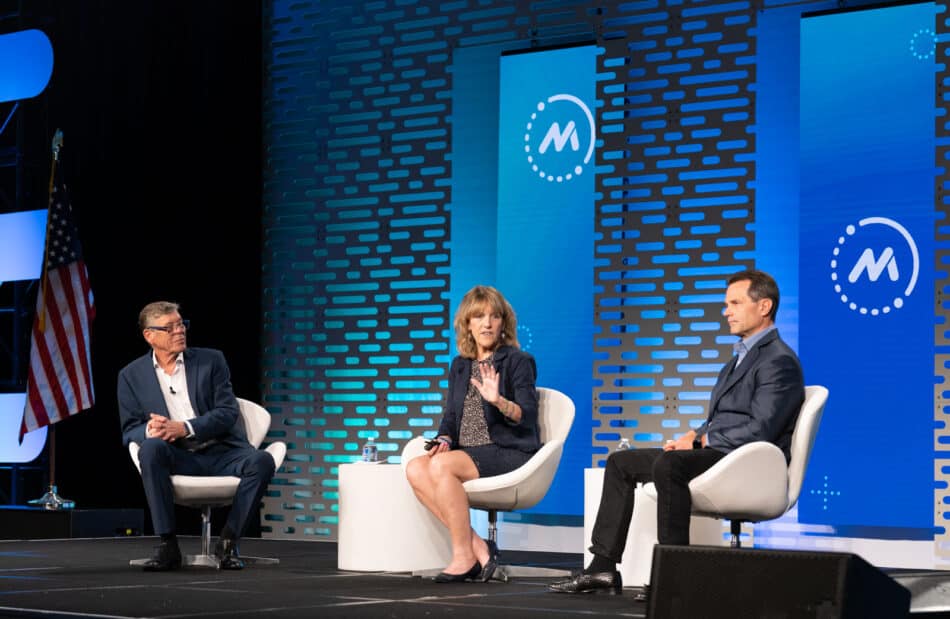
Lots of heads were nodding when Cynthia Farrer kicked off her opening comment of a fireside chat during the MLC’s Rethink 2022 Summit by noting that supply chain is something that everyone in the room is dealing with and it is top of mind.
Farrer, Senior Vice President of Global Operations and Integrated Supply Chain for Allegion, was joined by Ken Engel, Senior Vice President, Global Supply Chain North America for Schneider Electric, USA for the chat moderated by Paul Tate, MLC’s Co-Founding Executive Editor and Senior Content Director.
Throughout the discussion, Engel and Farrer shared how they’ve adapted to challenges and where they see improvement opportunities for supply chain management. To mitigate future disruption, they shared that it is important to gain visibility throughout the supply chain and line of sight into the entire ecosystem. At Schneider, for example, they have created an upstream supplier readiness plan that Engel referred to as “a plan for every part.”
Meanwhile, for those companies with limited resources or with a significant number of parts, Farrer recommends that companies identify the most important component parts and focus on gaining visibility and redundancy for those parts.
Ultimately, to create calmer supply chains and operations, Engel emphasized the need to partner closely with suppliers and acknowledge the important role employees play. People must be empowered to be agile as they navigate personal and business disruptions, according to Engel. In fact, Schneider Electric has found that by providing digital training to its workforce, there is greater engagement and excitement around the work.
Photo by David Bohrer / National Assoc. of Manufacturers
Rethink 2022: What’s the Real Value of M4.0?
Mastering data will help manufacturers unlock value they hadn’t thought of before.

“Today, we are still only scratching the surface of the M4.0 value proposition,” noted David R. Brousell, Co-founder of the Manufacturing Leadership Council during his opening speech this morning at the MLC’s Rethink 2022 Summit in Marco Island, Florida. “But I am convinced” he added, “that a powerful case can now be made that the already significant value that has been realized with M4.0 will be significantly surpassed in the days ahead.”
Speaking to a packed auditorium of 500 senior level manufacturers, industry experts, innovators, and academics at the MLC’s 18th Summit event, Brousell predicted that the manufacturing industry is now poised to cross a chasm with M4.0 – making the transition from initial visionaries and early adopters, to the next dimension of value from M4.0 through grounded pragmatism, focused application, and enterprise-wide deployment.
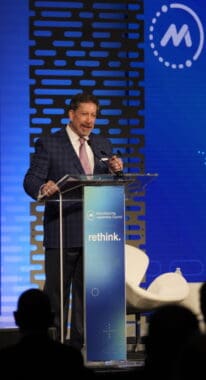 “The value that we will be able to generate from the digital model – whether that value is expressed in time, productivity, customer satisfaction, speed, or hard dollars – will be determined by our ability to master data, not only to improve what exists, but also to identify what might not yet exist – but could,” said Brousell.
“The value that we will be able to generate from the digital model – whether that value is expressed in time, productivity, customer satisfaction, speed, or hard dollars – will be determined by our ability to master data, not only to improve what exists, but also to identify what might not yet exist – but could,” said Brousell.
Mastering data, he believes, will deliver positive change in many areas – changing the jobs people do and how they execute those jobs; changing the processes by which manufacturers make things, assure their quality, and delight customers – driving greater efficiencies, speed, cost effectiveness, and productivity; and it will change product and service portfolios, leading to the creation of new revenue streams and new customers.
In the years ahead, he continued, it will also allow companies, and the industry at large, to reimagine the art of the possible, unleashing imagination, creativity, and innovation, and ultimately, enhancing manufacturing competitiveness on the global stage.
“So set your expectations high,” concluded Brousell. “Think big about the next phase of M4.0. and embrace something that Michelangelo once said. “The greater danger for most of us lies not in setting our aim too high and failing short, but in setting our aim too low, and achieving our mark.”
Manufacturing Tops Industrial Ransomware Hit List in 2021
Manufacturers are increasingly targeted for attack as cyber criminals refine their ransomware and adopt new business models to fund their operations.

Last year ransomware gangs turned up the heat against all industrial sectors, but manufacturers have the most to worry about amid this distressing rash of cyber extortion. The statistics show that in 2021 adversaries targeted manufacturing with industrial ransomware nearly twice as often as all the other industrial sectors combined.
It’s a trend that shows no sign of slowing down as adversaries increasingly recognize manufacturers as extremely profitable targets for ransomware schemes that encrypt and disable operational technology (OT) systems on the factory floor and beyond, requiring victims to pay for the keys to decrypt their files and restore functionality to their systems. Savvy ransomware groups recognize the value of uptime in the manufacturing industry and they’re ruthlessly profiting on the fact that manufacturers are often the least mature in their OT defenses compared to other industrial verticals.
Manufacturing Ransomware Statistics
Dragos identified the intensification of manufacturing ransomware through data compiled for its 2021 ICS/OT Cybersecurity Year in Review (YiR) report, an annual compendium of OT security statistics and observations.
YiR findings showed 2021 as a pivotal year for ransomware groups targeting OT systems, with ransomware becoming the number one driver for compromises in industrial environments. Weak boundaries and poorly understood interactions between OT and IT systems, coupled with the rise in remote access—especially as more organizations rely on their work-from-home staff—contributed to industrial ransomware’s rising trend lines.
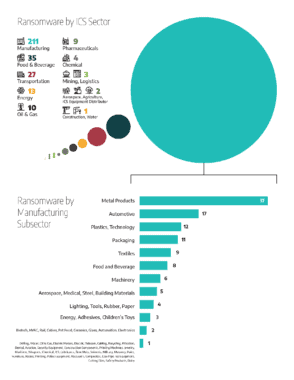
Broken down by industrial sector, manufacturing accounted for 65% of all the industrial ransomware incidents last year. Manufacturers suffered six times as many industrial ransomware incidents as the second leading sector, food and beverage, which suffered about 11% of last year’s attacks. Transportation came in third, accounting for about 8% of industrial ransomware attacks in 2021.
Digging deeper into the category of manufacturing ransomware incidents, the top three most common subsectors impacted by these attacks were Metal Components (17%), Automotive (8%), and Plastics/Technology (6%).
Rise in Ransomware Attacks
While ransomware still mainly targets enterprise IT systems, Dragos intelligence shows there are growing instances of these attacks that impact OT directly and in integrated IT and OT environments. Often ransomware adversaries indirectly attack OT systems as targets of opportunity after gaining initial access in adjacent and integrated IT systems. They use the compromise of critical enterprise IT systems to move laterally into OT. Some ransomware groups specifically target OT systems.
For example, EKANS is a specific ICS targeted ransomware that has gone after companies across electric, oil and gas, medical and pharmaceutical manufacturing, and automotive sectors. Dragos analyzed multiple variants of EKANS malware and discovered that the EKANS variant has the ability to stop ICS-related Windows processes before initiating encryption.
In 2021 the most prolific ransomware groups to attack OT systems were Conti and Lockbit 2.0, which caused 51 percent of total ransomware attacks, with 70 percent of their malicious activity targeting manufacturing. A lot of the success that groups like these have achieved in cyber extortion can be attributed to malicious business models like ransomware-as-a-service (RaaS) and sophisticated underground marketplaces where ransomware developers outsource operations to affiliates who execute the attacks. Affiliates do not require high-level technical expertise because the ransomware software has been developed and they can purchase access to systems and hackers for hire, which significantly lowers barriers to entry.
The DarkSide gang (now rebranded as REvil) offered customer service with real-time chat support andbrought in at least $60 million before it announced it was closing its operations. Investing in their business, ransomware groups are also funding research and development, which is fueling their industry as their extortion methods become more extreme. These are criminals, but they’re also savvy businesspeople, so manufacturers should expect them to continue to knock over vulnerable factory systems if they stand to make a handsome profit through ransoms readily paid by manufacturers who can’t afford to have their production ground to a halt.
What to Expect in 2022
Unfortunately, many manufacturers are still ill prepared to buffet these ransomware attacks before the adversaries have already stopped production. Dragos YiR analysis based on professional services engagements last year shows that 90% of manufacturers have limited visibility into their OT systems and the same percentage have set up poor network perimeters. Meantime, 80% of manufacturers have external connectivity exposed in OT systems and 60% utilize shared credentials that can easily be leveraged by ransomware groups to compromise systems.
Ransomware trends are likely to continue shifting as groups reform, reprioritize, and as law enforcement pursues them and takes them offline. As this evolution continues to evolve, Dragos analysts believe with a high degree of certainty that ransomware will continue to disrupt all industrial operations and OT environments through 2022, in manufacturing and beyond. Manufacturers should prepare now because ransomware actors’ extortion techniques will continue to grow in severity and intensity as adversaries deploy any means available to maximize their ransom profits.
To read more on OT cybersecurity trends, see the full Year in Review (YiR) report: https://www.dragos.com/year-in-review/
————————————————————————————————————
 Peter Vescuso is Vice President of Marketing at industrial cybersecurity provider Dragos and a member of the Manufacturing Leadership Council.
Peter Vescuso is Vice President of Marketing at industrial cybersecurity provider Dragos and a member of the Manufacturing Leadership Council.
Disrupt the Disruption in Manufacturing Supply Chains
Track and trace can improve resiliency and response
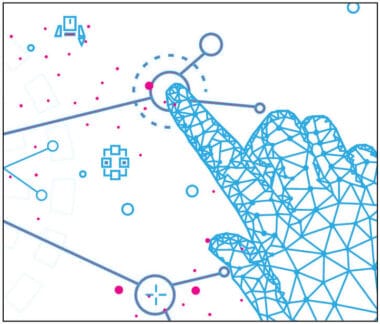
The past two years will get plenty of blame for supply chain disruption, but disruption — from human and technology error to weather and other crises — has always been a challenge. Manufacturers are using dashboards to visualize performance measurements and gain deeper diagnostics for uses like preventative maintenance and process optimization. But while they are a critical starting point, supply chain dashboards are not enough. Today’s manufacturers need a way to move from data collection through the supply chain to decision support and actionable insights.
In his supply chain management research, MIT Professor Yossi Sheffi noted that those companies that thrive and survive amid supply chain disruption bring people together in control centers creating a “plan B” for when disruption occurs, and a centralized area of focus for data and insights. Track and trace solutions build on the control tower concept to bring manufacturers the insights needed to improve responsiveness and build supply chain resilience.
The goal is to evolve beyond what typical control towers offer, delivering the ability to autonomously alert or trigger workflows and provide decision support. Tracking and tracing key components and products all through the supply chain provides the core data for eventual autonomous management and control from supplier to the factory and the factory to the customer. In larger factories there is a growing need to apply the same level of tracking and tracing.
Track and Trace in Manufacturing
In a nutshell, a proven track and trace approach will allow you to use the same infrastructure to track multiple sources: materials, products in production, assets, and people. Specifically, the track and trace solution the technology you’re looking for can:
Track and trace the order through the plant by mounting tags and dynamically associating the work order with the tags. This approach supports seamless tracking throughout production, even when the material moves into a different zone or is transferred to a different holding device or tag, or the source of data changes (RFID to GPS to BLE).
Manage events in the zone by monitoring how the movable assets go in and out of areas of production and shipping and sending alerts to managers as needed. For example, an alert is generated if an operator moves a specially calibrated tool from one zone to another, where it might disrupt the production process.
Make assets easy to configure and visualize. Typically, when managers and operators encounter a problem, they don’t want to get bogged down creating or waiting for code. They just want to fix it. A successful track and trace solution will operate via an intuitive administrative interface. For example, it may allow upload of JPG or PNG images of technical factory drawings to provide the image needed to designate zones (production line, workspace, machine) and associate appropriate tracker readers (RFID, BLE and QR).
Use cases for track and trace range from in-production and location or work-in-progress tracking to finished goods and in-transit tracking: The solution will produce alerts if your materials are in the wrong location, inadequate or haven’t reached assembly station. It will report the absence of qualified people at specific station, receipt, and placement of a shipment, and how much of your product is on hand and ready to ship, as well as on the journey from factory to warehouse.
A caveat to the track and trace solution proposition is that your people must be ready for it. As you put the solution together it is important to involve your people in the journey so that they are ready for change.
The value proposition for the control tower with track and trace technologies is the extensiveness of the solution. Going beyond just visualization of the activity in your supply chain, track and trace enables the complex analytics involving materials, people, and assets, that produce actionable insights. It brings autonomous capabilities to tracking, identifying deviations, and predicting where issues may occur — disrupting any disruption in your manufacturing supply chain.
Owen Keates is Industry Executive Asia-Pacific Manufacturing Practice for Hitachi Vantara.
Digital Transformation: The Necessity for ‘Unified Leadership Alignment’
Company manufacturing leaders need to get on the same page with digital transformation projects if they are going to succeed
As any company that has undertaken a digital transformation knows from sometimes painful experience, transitioning to the digital model of manufacturing includes overcoming many obstacles. Over the last several years, MLC research has revealed that dealing with legacy systems, keeping abreast of new technologies, and developing return-on-investment models for digital manufacturing expenditures are among the most important challenges manufacturers say they face in their Manufacturing 4.0 journeys.
There are several cultural and organizational issues that manufacturers must sort through as well. After all, digital transformation should not be thought of as just another technology project; it is an undertaking the entirety of the organization must be involved with since it will inevitably change nearly every aspect of how work is conducted, how products are built, and, perhaps most importantly, how power and authority flows in a company.
This aspect of an M4.0 journey – the internal organizational dynamics – was highlighted in a recent MLC Master Class Executive Interview program with NTT DATA, an MLC member company. The program centered on a new survey called “The Road to Industry 4.0” produced by NTT DATA and Oxford Economics. In a question-and-answer session I had with Baskar Radhakrishnan, NTT DATA’s Strategic Advisor for Manufacturing, I asked Mr. Radhakrishnan what he thought were the most important challenges faced by manufacturers as they attempt to get underway with M4.0. He didn’t hesitate: “A lack of unified leadership alignment.”
Why is it so difficult sometimes to get key stakeholders on the same page regarding a strategic move like a digital transformation? In some companies, I think it simply could be that not everyone clearly understands the goals and benefits of such an undertaking. But I also think part of the answer can be found in the words of that question. Digital transformations, by their nature, can indeed be strategic, meaning that they could involve a fundamental or major change in the direction of a company. And the word transform – which means “to change in condition, nature, or character” – clearly signals that what came before may not continue ahead.
As we all know and may have experienced in our own business lives, change can be hard and even frightening when patterns of work or even job roles change. And at the executive level, the often-unmentioned additional elements of power and prestige can come into play. One can role-play typical questions: ‘How will a digital transformation affect my area of expertise and control and my career path?’ ‘I have many years in manufacturing, but do I have enough understanding of digital to continue to contribute or will I become obsolete?’ ‘How can I be sure that the company will continue to be successful after a digital transformation?’
Add into this mix the still relatively early stage the industry is in with regards to codifying the payback and benefits of digital transformation and it is not hard to understand why some executives, including those long in place in their careers and jobs, may still have questions or even hesitancy about a strategy that transforms.
Nevertheless, the unified leadership alignment cited by Mr. Radhakrishnan not only needs to be done but can be done if manufacturing leadership takes the right steps and follows through. My interpretation of this is that leadership needs to work hard to clearly formulate and articulate the vision, goals, and objectives of a digital transformation to everyone in the organization, especially the leadership team which will ultimately be charged with carrying the message and developing the strategy and planning needed to see a transformation through to a successful conclusion. This involves a whole gamut of work, from envisioning a new and better business end state enabled by digital transformation to how a transformation can benefit the individual employee. And leadership needs to be open and transparent about the challenges along the way even as those challenges are being defined as the journey proceeds.
Obviously, this is quite an undertaking for leadership, requiring great reservoirs of stamina and persistence. After all, digital transformation isn’t an option anymore. It’s a business necessity if a company wants to not only survive but thrive in the years ahead. And that may be all the motivation a manufacturer needs to press head.
For an additional resource and further insights, access to the recent NTT DATA and Oxford Research study can be found here:
https://us.nttdata.com/en/engage/the-road-to-industry-4-0.
